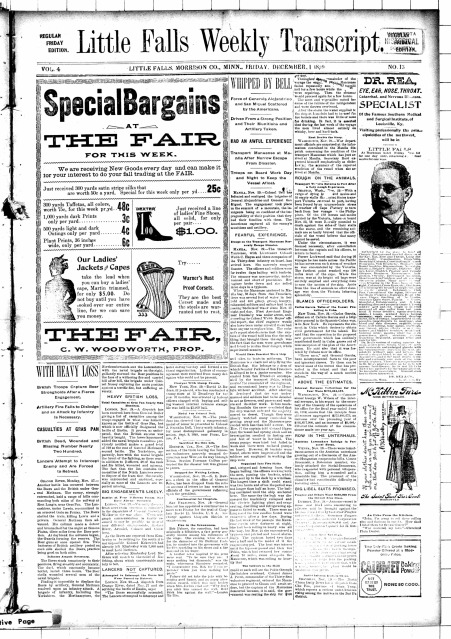Little Falls Transcript
Little Falls transcript (Little Falls, Minn.) 1876-1894 Browse the title
Little Falls weekly transcript (Little Falls, Minn.) 1894-1901 Browse the title
Little Falls daily transcript (Little Falls, Minn.) 1892-1982 Browse the title
With the motto to "print the news when it’s news," the Little Falls Transcript began weekly publication in September 1876, under the editorial direction of Henry Clay Stivers. Throughout the 1890s, the Transcript was one of four newspapers published in Little Falls, Minnesota. Along with the Little Falls Herald, the Morrison County Democrat, and for a brief period, the Little Falls Sun, the Transcript served the community of Little Falls with a wide range of local and national news. In addition to local circulation, the Transcript had a subscriber base that extended to greater Morrison County, including the towns of Pierz, Buckman, Motley, Royalton, and Swanville. The Transcript was decidedly Republican in its politics, a point of fact that regularly put the Transcript at odds with the other Little Falls papers that were staunchly Democratic.

Starting with a four-page, six-column format, Henry Clay Stivers added a daily edition, the Daily Transcript, in 1880. In 1881, Stivers leased his operation to John Frazier Pearson, who discontinued the daily edition and put his energy into the weekly paper. By 1889, ownership of the paper had passed to 27-year-old Wheaton Matthew Fuller, a native of Little Falls who had apprenticed under Stivers. It was under Fuller’s leadership that the Transcript saw its greatest period of growth.
In the spring of 1892, Fuller incorporated the Transcript Publishing Company. He was joined in this endeavor by several prominent Little Falls residents, including Charles A. (Charles August) Lindbergh, Sr., a lawyer, Republican U.S. congressman, and father of famous pilot Charles A. (Charles Augustus) Lindbergh. Chief among the new company’s objectives were the continued publication of the weekly edition of the Transcript, as well as the establishment of an eight-page, seven-column daily edition, called the Little Falls Daily Transcript. In 1898, the Little Falls Weekly Transcript began publishing twice a week, the Regular Friday Edition and a Special Tuesday Edition. This service, "of benefit to country readers…to receive the news oftener than once a week…," continued at least until January 18, 1901. Besides its newspaper operations, the Transcript Publishing Company also served as a full-service print shop for the residents of Little Falls and neighboring communities. Describing itself as the "biggest little print shop in the state," the Transcript Publishing Company maintained a minimum full-time staff of 18, six of whom were dedicated to providing daily delivery service.
In addition to publishing two newspapers, Wheaton Fuller also served as postmaster of Little Falls and was active in county and state politics. He served in 1893 in the Minnesota State House of Representatives and in the Minnesota State Senate in 1895. Fuller’s tenure as editor and publisher of the Little Falls Transcript lasted for 27 years, until his death in 1908 at age 45. Following his death, Fuller’s widow, Clara, became editor of the Transcript, postmistress of Little Falls, and majority owner of the Transcript Publishing Company. She held these positions until her death in 1941, when ownership of the paper passed to Edward LaFond.
By 1949, the Little Falls Transcript had ceased its weekly edition and had acquired its main competitor, the Little Falls Herald, leaving the Transcript the only daily newspaper published in Little Falls. The Daily Transcript continued publication for several decades thereafter. In 1975, it was purchased by Speidel Newspapers, Incorporated, a publishing company that also owned the St. Cloud Daily Times. In 1982, Speidel Newspapers, Inc. was acquired by the Gannett Company, which then consolidated the Daily Transcript with the St. Cloud Daily Times. The last issue of the Little Falls Daily Transcript was published on November 22, 1982.